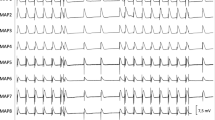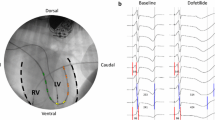Abstract
An increase in dispersion of myocardial refractoriness has been shown to coincide with a greater risk of inducible ventricular arrhythmias. We compared the dispersion of electrophysiologic parameters and antiarrhythmic effects of dofetilide (0.03, 0.1, 0.3 and 1 mg/kg i.v.) in postinfarcted anesthetized dogs. Animals were tested for inducibility of arrhythmias using a programmed electrical stimulation (PES) protocol, and divided into inducible (1) and non-inducible (NI) groups. In addition, myocardial vulnerability was measured using ventricular fibrillation thresholds (VFT), as well as susceptibility to sudden cardiac death (SCD). Dofetilide significantly increased ventricular effective refractory periods (ERP) and monophasic action potential durations (APD) in a dose-dependent manner. The standard deviation of ERP, which was used as an index of dispersion of refractoriness, increased from sham (control value of 5.4±sd2.5 ms), non-inducible (control value of 11.0 ±5.5 and 8.0±3.7 ms for vehicle and dofetilide groups, respectively) and inducible states (control value of 17.3±6.2 and 21.6±7.1 ms for vehicle and dofetilide groups, respectively). However, dofetilide treatment did not alter dispersion of refractoriness over the dose range studied. Dofetilide did not significantly increase inducibility in the NI group (2 out of 8[25%] compared to 0 out of 9 [0 %] in vehicle treated animals). In the I group, dofetilide (0.3 mg/kg) treated animals converted 2 out of 7 (29 %) to NI, and 5 out of 7 (71 %; significant at p<0.05) to a NI or non sustained ventricular tachycardia. There were no significant changes in VFT following the last dose of dofetilide given. Dofetilide did not significantly affect SCD survival (88 % and 29 % in the NI and I group, resectively) relauve to vehicle (66 % and 50 % in the NI and I group, respectively). Although infarct sizes were significantly greater in the I groups, there was no difference between vehicle and dofetilide animals within these groups. In conclusion, dofetilide increased ERP and APD values, but did not affect dispersion of refractoriness. Thus, changes in dispersion of refractori ness may be used as a marker for inducibility in untreated animals, but it did not predict the antiarrhythmic effects observed with dofetilide.
Similar content being viewed by others
References
Allessie MA, Bonke FIM, Schopman FJG (1976) Circus movement in rabbit atrial muscle as a mechanism of tachycardia: II. The role of nonuniform recovery of excitability in the occurrence of unidirectional block, as studied with multiple electrodes. Circ Res 39: 168–177
Anderson JL, Rodier HE, Green LS (1983) Comparative effects of betaadrenergic blocking drugs on experimental fibrillation threshold. Am J Cardiol 51: 1196–1202
Antzelevitch C, Sicouri S, Litovsky SH, Lukas A, Krishnan SC, DiDiego JM, Gintant GA, Liu D-W (1991) Heterogeneity within the ventricular wall. Electrophysiology and pharmacology of epicardial, endocardial and M cells. Circ Res 69: 1427–1449
Barber MJ, Mueller TM, Henry DP, Felten SY, Zipes DP (1983) Transmural myocardial infarction in the dog produces sympathectomy in noninfarcted myocardium. Circulation 67: 787–796
Black SC, Chi L, Mu D-X, Lucchesi BR (1991) The antifibrillatory actions of UK-68-798, a Class III antiarrhythmic agent. J Pharmacol Exp Then 258: 416–423
Black SC, Lucchesi BR (1992) UK-68-798, a class III antiarrhythmic drug with antifibrillatory properties. Cardiovasc Drug Rev 10: 170–181
Butrous GS, Gough WB, Restivo M, Yang H, El-Sherif N (1992) Adrenergic effects on reentrant ventricular rhythms in subacute myocardial infarction. Circulation 86: 247–254
Carmeliet E (1992) Voltage-and timedependent block of the delayed K+ current in cardiac myocytes by dofetilide. J Pharmacol Exper Ther 262: 809–817
Corr PB, Shayman JA, Kramer JB, Kipnis RJ (1981) Increased α-adrenergic receptors in ischemic cat myocardium. J Clin Invest 67: 1232–1236
El-Sherif N, Gough WB, Restivo M (1991) Reentrant ventricular arrhythmias in the late myocardial infarction period. Mechanism by which a shortlong-short cardiac sequence facilitates the induction of reentry. Circulation 83: 268–278
Gough WB, eehra R, Restivo M, Zieler RH, El-Sherif N (1985) Reentrant ventricular arrhythmias in the late myocardial infarction period in the dog: 13. Correlation of activation and refractory maps. Circ Res 57: 432–442
Greenberg SS, Luisi A, Long JP, Williamson HE (1992) Pharmacology of sematilide, a non-quaternary class III antiarrhythmic agent. Drug Dev Res 25: 283–302
Gwilt M, Blackburn KJ, Burges RA, Higgins AJ, Milne AA, Solca AM (1992) Electropharmacology of dofetilide, a new class III agent, in anaesthetised dogs. Eur J Pharmacol 215: 137–144
Haberman RJ, Rials SJ, Stohler JL, Marinchak RA, Kowey PR (1993) Evidence for a reexcitability gap in man after treatment with type I antiarrhyth mic drugs. Am Heart J 126: 1121–1126
Han J, Moe GK (1964) Nonuniform recovery of excitability in ventricular muscle. Circ Res 14: 44–60
Kammerling JJ, Green FJ, Watanabe AM, Inoue H, Barber MJ, Henry DP, Zipes DP (1987) Denervation supersensitivity of refractoriness in noninfareted areas apical to transmural myocardial infarction. Circulation 76: 383–393
Kiehn J, Villena P, Beyer T, Brachmann J (1994) Differential effects of the new Class III agent dofetilide on potassium currents in guinea pig cardiomyocytes. J Cardiovasc Pharmacol 24: 566–572
Kowey PR, Friehling TD, Sewter J, Wu Y, Sokil A, Paul J, Nocella J (1991) Electrophysiological effects of left ventricular hypertrophy. Effect of calcium and potassium channel blockade. Circulation 83: 2067–2075
Krishnan SC, Antzelevitch C (1991) Sodium channel block produces opposite electrophysiologic effects in canine ventricular epicardium and endocardium. Circ Res 69: 277–291
Liu D-W, Gintant GA, Antzelevitch C (1993) Ionic bases for electrophysiological distinctions among epicardial, midmyocardial, and endocardial myocytes from the free wall of the canine left ventricle. Circ Res 72: 671–687
Mehra R, Zeiler RH, Gough WB, El-Sherif N (1993) Reentrant ventricular arrhythmias in the late myocardial infarction period: 9. Electrophysiologicanatomic correlation of reentrant circuits. Circulation 67: 11–24
Michelson EL, Spear JF, Moore EN (1980) Electrophysiologic and anatomic correlates of sustained ventricular tachyarrhythmias in a model of chronic myocardial infarction. Am J Cardiol 45: 583–590
Mines GR (1914) On circulating excitations in heart muscle and their possible relation to tachycardia and fibrillation. Trans R Soc Can 8: 43–52
Moore EN, Spear JF, (1975) Ventricular fibrillation threshold. Arch Intern Med 135: 446–453
Morgan JM, Cunningham D, Rowland E (1992) Dispersion of monophasic action potential duration: Demonstrable in humans after premature ventricular extrastimulation but not in steady state. J Am Coll Cardiol 19: 1244–1253
Mukherjee A, Wong TM, Buja LM, Lefkowitz RJ, Willerson JT (1979) Betaadrenergic and muscarinic cholinergic receptors in canine myocardium. Effects of ischemia. J Clin Invest 64: 1423–1428
Nelson SD, Coyne K (1992) Electrophysiologic effects of selective B1 adrenergic stimulation in the late phase of myocardial healing. Intern J Cardiol 36: 95–102
Ogawa A, Furuno I, Satoh Y, Yoh S, Saeki K, Sadanaga T, Katoh H, Nakamura Y (1991) Quantitative indices of dispersion of refractoriness for identification of propensity to re-entrant ventricular tachycardia in a canine model of myocardial infarction. Cardiovasc Res 25: 378–383
Rasmussen HS, Allen MJ, Blackburn KJ, Butrous GS, Dalrymple HW (1992) Dofetilide, a novel class III antiarrhythmic agent. J Cardiovasc Pharmacol 20: S96-S105
Rosen MR, Gelband H, Hoffman BE (1971) Effects of phentolamine on electrophysiologic properties of isolated canine Purkinje fibres. J Pharmacol Exp Ther 179: 586–593
Sanguinetti MC, Jurkiewicz NK (1990) Two components of cardiac delayed rectifier K+ current. J Gen Physiol 96: 195–215
Scaelse RJ, Burkett DE, Sadanaga KK, D'Alonzo AJ, Barbour S, Clemons AF, Darbenzio RB, Hess TA, Sedlatschek MA, Sewter JC (1993) Coronary artery occlusion/reperfusion. A canine model of myocardial infarction. A retrospective study in 211 dogs: Results and research applications. J Invest Surg 6: 380
Segwick ML, Rasmussen HS, Cobbe SM (1992) Effects of the Class III antiarrythmic drug dofetilide on ventricural monophasic action potential duration and QT interval dispersion in stable angina pectoris. Am J Cardiol 70: 1432–1437
Sheridan DJ, Culling W (1985) Electrophysiological effects of α-adrenoceptor stimulation in normal and ischemic myocardium. J Cardiovasc Phamacol 7: S55–60
Spinelli W, Parsons RW, Colatsky TJ (1992) Effects of WAY-123, 398 a new class III antiarrhythmic, on cardiac refractoriness and ventricular fibrillation threshold in anesthetized dogs: A comparison with UK-68798, E-4031, and dl-sotalol. J Cardiovasc Pharmacol 20: 913–922
Tanabe T, Takahashi K, Usui K, Kitada M, Mori H (1993) Effects of bunazosin, a selectiveα 1-blocking agent, and propranolol used alone and in combination on canine ventricular refractoripess and its dispersion during myocardial ischemia. J Cardiovasc Pharmacol 21: 600–608
Wetstein L, Mark R, Kelliher GJ, Friehling T, O'Connor KM, Kowey PR (1985) Arrhythmia inducibility and ventricular vulnerability in a chronic feline infarction model. Am Heart J 110: 955–960
Wilber DJ, Lynch JJ, Lucchesi BR (1985) Electrophysiologic effects of prazocin during acute myocardial ischemia. Eur J Pharmacol 127: 157–161
Author information
Authors and Affiliations
Rights and permissions
About this article
Cite this article
D'Alonzo, A.J., Sewter, J.C., Darbenzio, R.B. et al. Effects of dofetilide on electrical dispersion and arrhythmias in post-infarcted anesthetized dogs. Basic Res Cardiol 90, 424–434 (1995). https://doi.org/10.1007/BF00788505
Received:
Revised:
Accepted:
Issue Date:
DOI: https://doi.org/10.1007/BF00788505




